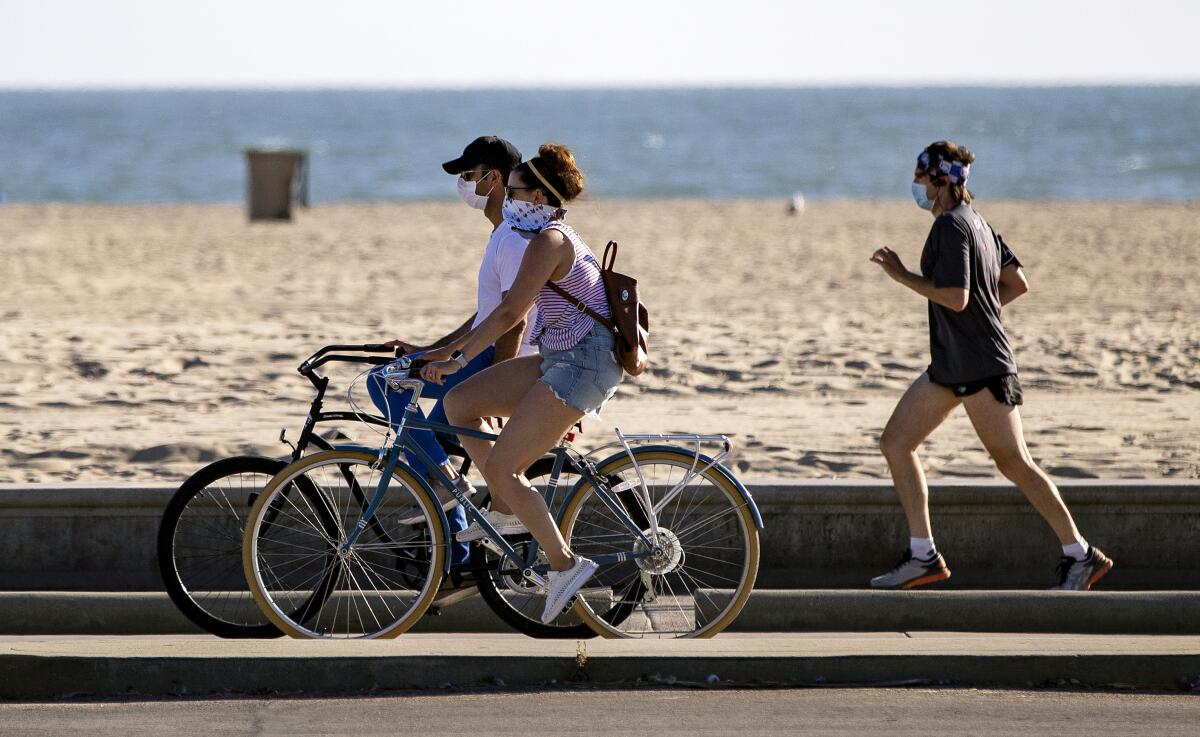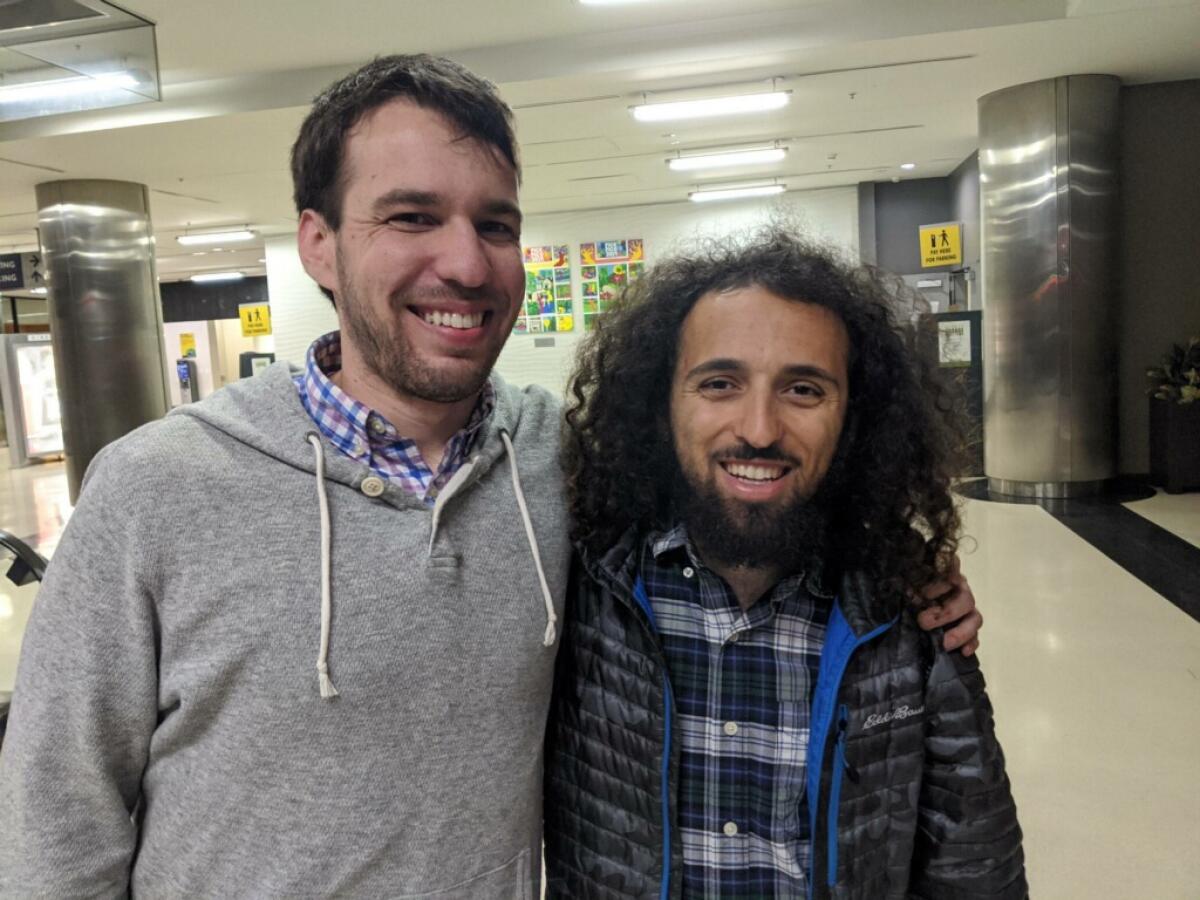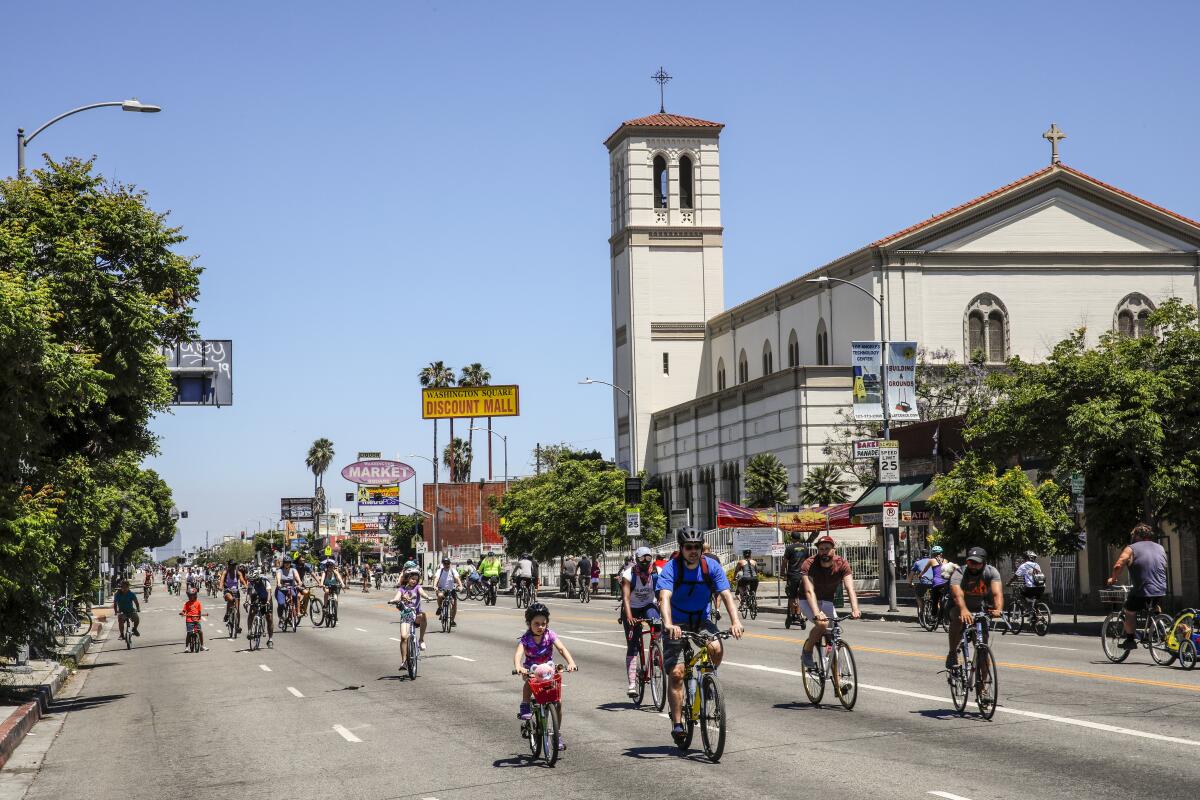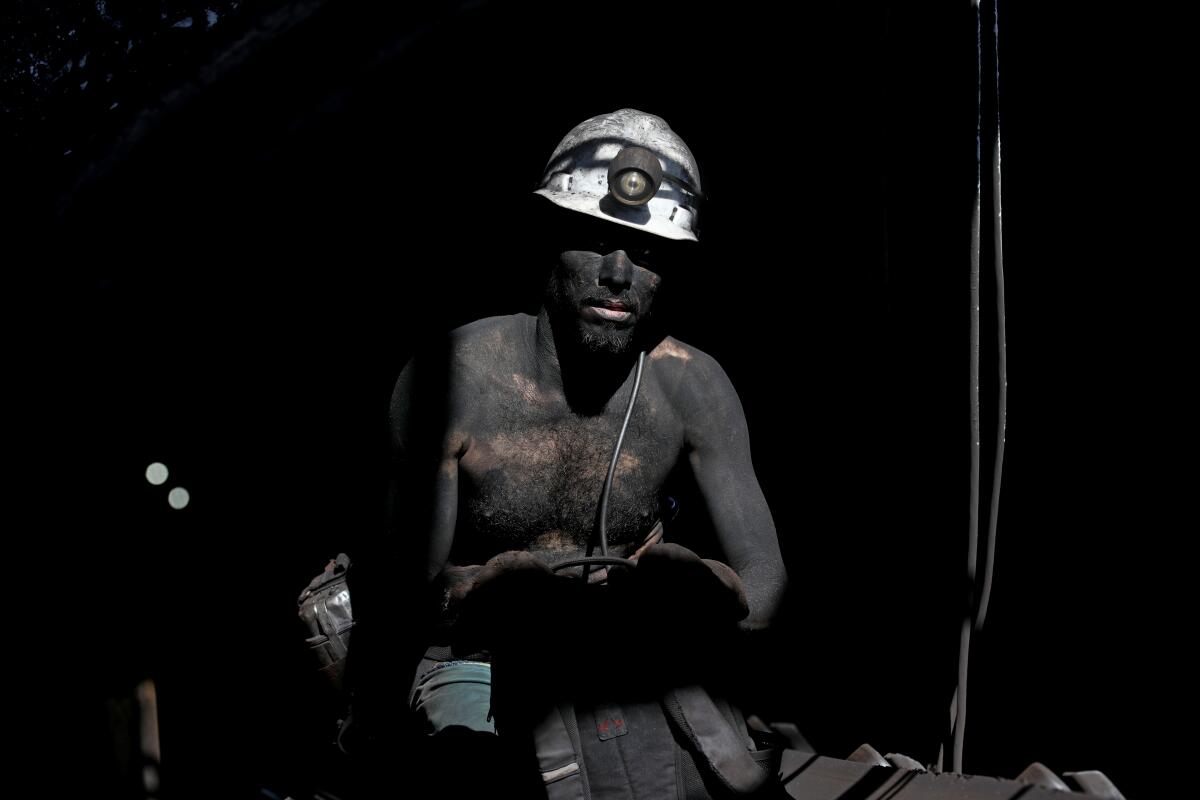My friend was killed riding a bike. He wanted cities built for people, not cars

This is the April 15, 2021, edition of Boiling Point, a weekly newsletter about climate change and the environment in California and the American West. Sign up here to get it in your inbox.
On Friday in Washington, D.C., a bicyclist was killed in a multi-car crash after getting hit by a driver. He’s one of roughly 850 bikers and 6,200 pedestrians who will be killed this year in traffic collisions in the United States, if recent years are anything to go by.
We hear about deadly crashes all the time, and many of us in car-centric Southern California shrug it off as an unfortunate but unavoidable fact of life. Only this time, for me, it was personal. The cyclist was a friend of mine, Jim Pagels.
Jim and I were college classmates in New York. He was vibrant, funny and full of passion for denser, safer, more livable cities. When he visited Los Angeles last year — days before the pandemic’s first stay-at-home orders — he kept me updated on his enthusiastic use of the city’s public transit systems, including taking a bus across town to meet me for dinner at the Westside Pavilion.
His final tweet — sent a few hours before his death — lamented D.C.’s shortage of safe pathways for cyclists.

There’s a growing movement in Los Angeles and across the country calling for cities designed for people, not cars. It’s a campaign motivated by climate change and air quality concerns in addition to safety and healthier lifestyles. The easier it is for people to walk, bike and take public transit, the fewer greenhouse gases and lung-damaging chemicals will be spewed by tailpipes.
And as I noted last week, activists point to other benefits, too. The less space taken up highways and parking lots, the more land will be available for housing, parks and the outdoor dining areas that have become so popular during the pandemic.
To learn more about the fight for safe streets — and to honor my friend Jim — I talked with Michael Schneider, founder of L.A. political action committee Streets for All. The following highlights from our conversation are edited and condensed for clarity.
ME: How did you come to start this organization?
SCHNEIDER: I was born and raised in Los Angeles. And like many people in Los Angeles, I was at the DMV at 8 a.m. on my 16th birthday. My self-esteem in high school was dictated by if my car had chrome rims. I was one of those people that would get in my car, drive three blocks to the grocery store and complain there wasn’t enough parking.
About nine years ago, I dusted off an old bicycle and challenged myself for a week to see if I could get around town without dying. And not only did I not die, I fell in love with the lifestyle, with how I felt mentally and physically, with how I was never late because I was looking for parking, how I was never late because of rush-hour traffic.
And then my wife and I started having kids. And when you have a small child on the bike with you, and cars do what cars do — which is honk, come up and tail you too close behind, pass you too closely — I started to get really, really frustrated, and frankly resentful, that I had to risk my life every day just because I didn’t want to drive. It didn’t seem fair.
ME: What would it mean in practice to have “streets for all”?
SCHNEIDER: I think our logo says it all. There’s a picture of someone on a scooter, someone walking, someone in a wheelchair. A bike, a bus, a train. There’s a picture of a car in our logo. We are not anti-car.
But we are against people having to risk their life to ride a bicycle, and we are against a bus taking two, three, four, five times as long as a car because they don’t get dedicated lanes and they’re stuck in traffic. We believe in a more equitable distribution of our shared road space where those things are fixed.
And how do you fix them? You give the bus its own red-painted, 24/7 bus lane. I promise you, if you’re stuck in traffic day in and day out, and you see a bus constantly flying past you, at some point you’re going to perk up and say, “Why am I stuck in traffic?” and try the bus. For people biking, we want true protected, ideally curb-level bike lanes, like they have in Europe.
ME: Talk about the connection to climate change. And why can’t we just replace our gas guzzlers with electric vehicles?
SCHNEIDER: If you look at the stats in California, transportation is by far the single biggest emitter of greenhouse gases. If you care about climate, which most people say they do, then you should care about changing how people get around cities.
I wrote an article recently called, “Why electric cars aren’t a panacea.” The main reason is they take up the same amount of space as non-electric cars, so they don’t solve the insatiable demand for parking space and driving space. And they’re just as dangerous. If you get hit by an electric Hummer versus a non-electric Hummer, you’re still probably going to die.
If we have to have vehicles — and we’re always going to have some vehicles — they should be electric. But there’s such a huge emphasis on electric cars, no one pays attention to more boring, less sexy solutions, like bike and bus lanes.
ME: Six years ago, L.A. Mayor Eric Garcetti set a goal of zero traffic-related deaths by 2025, part of the global Vision Zero initiative. So far, we’re not on track to meet that goal. My colleague Steve Lopez recently reported that 238 people died in car crashes in Los Angeles last year — only a tiny decrease from 2019 despite significantly reduced traffic due to COVID-19, and just 8% less than the first full year Garcetti’s policy was in effect. What is going on?
SCHNEIDER: Our city is very good at plans and goals and not very good at implementation. Can you imagine if you were a heart surgeon and people were coming in for heart surgery, and no one would let you operate? Vision Zero is a laudable goal, but until we have a City Council and a mayor who will spend the political capital to make the tough decisions and deal with NIMBY blowback to make changes to our streets, it’s never going to happen.
ME: Talking about blowback, I read the post you wrote about the proposed “Uplift Melrose” project, which would have added protected bike lanes, wider sidewalks and shaded seating areas along a 1.3-mile stretch of Melrose Avenue. There was broad support from local businesses, but City Councilmember Paul Koretz effectively killed the proposal. Why is it so difficult politically to get changes like these approved?
SCHNEIDER: Opponents typically say the following: If you remove parking or reduce car capacity in any way, how are people going to shop or get to businesses? You’re going to kill business. They also ask, “Why would we invest in this when no one uses the bike lanes anyway?” People cite anecdotes of driving by bike lanes and seeing them empty.
If we had a beautiful six-lane paved highway that only went for one mile and then became a dirt road with potholes, how many cars would take that road? That is the equivalent of what we ask people to do when they bike around Los Angeles. If we had a network of protected bike lanes, you would see a ton of people using them. One piece of evidence is CicLAvia. Those events bring out tens of thousands of people to ride their bikes on closed streets.
What happened to Uplift Melrose was egregious even by L.A. standards. Koretz basically became a puppet for mostly white, wealthy homeowners who couldn’t see themselves riding a bike or a bus.

ME: Another City Council member, Mike Bonin, faced a recall campaign when he supported eliminating a few miles of traffic lanes and adding a few miles of bike lanes in Playa del Rey. There were people in the neighborhood who were furious about the possibility of slower drive times. And they ultimately got those traffic lanes restored.
SCHNEIDER: Seleta Reynolds, the general manager of the L.A. Department of Transportation, was our guest on a Streets For All happy hour recently, and I asked her about this. She said removing those bike lanes was one of the hardest things she’s had to do in her career. A 16-year-old girl had been killed by a car going too fast, and she fought not to return that street to the way it was before. But she said everybody has a boss, and her boss, the mayor, told her to do it.
ME: Where has Mayor Garcetti been on safe streets?
SCHNEIDER: Absent. He says all the right stuff, and he hires great people, like Seleta Reynolds. He will never risk his neck at all for a bike lane or a bus lane.
But I think we’re on the cusp of some exciting changes, especially because the city of Los Angeles has now aligned their elections with federal elections, and the turnout is so much larger and so much more progressive. I think we are on the cusp of truly having different political leadership, where a guy like Paul Koretz, who’s termed out, couldn’t win in 2022 and beyond. And where someone like Nithya Raman, who had making the city more bikeable in her campaign messaging, can defeat an incumbent.
ME: There have already been some changes recently, right? The city has added over 50 miles of “slow streets” since the start of the pandemic, encouraging drivers to slow down so that people can walk and bike and play outside more easily while staying socially distanced. (Map here.) I’ve got a few of them in my neighborhood.
SCHNEIDER: The city has done surveys, and almost 90% of people want slow streets to remain permanent. But we need to work on the implementation and make sure drivers respect it — or have to respect it because of the geometry of the street.
And the city has a waitlist of nearly 300 pending slow street applications, of which each application is two to three miles. So there’s literally hundreds of miles of slow streets that are desired.
::
Los Angeles is not going to reshape its road spaces overnight. But it’s a conversation that can’t wait.
As my friend Finn Vigeland, who was close with Jim, told the Washington Post: “He cared so deeply about the injustices that led to his death, and he would want us to be furious about it. I hope that knowing that this was something Jim was working so hard to change might prompt people to take bolder action.”
And now, here’s what’s happening around the West:
TOP STORIES
A California Senate committee killed a bill that would have banned fracking and required health and safety buffers around oil and gas wells. The bill fell one vote short, my colleague Phil Willon reports, with two Democrats abstaining: Bob Hertzberg of Los Angeles and Ben Hueso of San Diego. For a reminder of why that matters, read this story by Judith Lewis Mernit for Yale Environment 360 about the health problems suffered by young people, including cancer, near fossil fuel extraction sites in the L.A. area. Also in the L.A. area, there was an oil spill last week at the country’s largest urban oil field, Leila Miller reports for The Times.
It’s been nearly 50 years since DDT was banned, but we’re still living with health consequences from the pesticide. The Times’ Rosanna Xia reports on alarming new research finding that granddaughters of women exposed to DDT are more likely to be obese and start menstruating before age 11, putting them at greater risk of breast cancer, diabetes and other diseases. One of those women posed this question: “How many times have we talked about climate change and things we need to do better for our children and grandchildren? This is more proof that hello, what we do today is going to affect people way forward.”
Gov. Gavin Newsom signed a $536-million wildfire prevention bill near a Lake Oroville boat ramp that doesn’t reach the receding water, as dry conditions point to an early fire season. Our Sacramento bureau chief, John Myers, has all the details on the bill, which includes funding for prescribed burns, fuel breaks and fortifying older homes against flames. There have already been twice as many fires in California in 2021 compared to this time last year, per the AP’s Adam Beam and Don Thompson.
WATER IN THE WEST
Toward a more sustainable California
Get Boiling Point, our newsletter exploring climate change, energy and the environment, and become part of the conversation — and the solution.
You may occasionally receive promotional content from the Los Angeles Times.
How bad are drought conditions? Bad enough that many farmers in the Klamath River Basin — which straddles the California-Oregon state line — might get no water at all for the first time in 20 years, Gillian Flaccus reports for the Associated Press. The last time that happened, farmers formed a “bucket brigade” to illegally scoop water from the river. Here in Southern California, the giant Metropolitan Water District says it’s got enough water to weather this year — but it’s still looking to spend up to $44 million to buy as much as 65,000 acre-feet of water from the Sacramento Valley, as Dale Kasler reports for the Sacramento Bee.
The decline of the West’s saline lakes is a long-term trend, but acute droughts can spur faster drying. For an example, read this beautifully written story on Utah’s shrinking Great Salt Lake, by Lauren Steele for Deseret Magazine. It’s a story about climate change, water waste, snowpack, tourism, brine shrimp and air quality. It’s got parallels to California’s Salton Sea, where progress on restoration continues to be extremely slow — but at least there’s some progress to report, per the Desert Sun’s Mark Olalde.
Amid all the focus on not having enough water, we shouldn’t lose sight of the many people who do have access to water, only it isn’t clean. This is an especially big problem in California. A new report from state officials found that 326 public water systems don’t consistently provide drinking water that meets health standards, according to Circle of Blue’s Brett Walton.
ON OUR PUBLIC LANDS

The endangered black toad’s last stronghold is a wildly remote college campus in the Great Basin Desert near Yosemite National Park. Climate change is one of many threats facing the species, The Times’ Louis Sahagun reports. His story focuses on researchers trying to encourage mating among the toads, which have the smallest range of any North American amphibian.
Interior Secretary Deb Haaland visited Utah’s Bears Ears, meeting with tribal leaders and local politicians before making a recommendation to President Biden on whether to restore the national monument to its pre-Trump boundaries. The Salt Lake Tribune’s Zad Podmore has all the details from Haaland’s tour. David Treuer, meanwhile, argues in a thought-provoking piece for the Atlantic that America’s national parks should be returned to the Indigenous peoples from whom the land was stolen.
President Biden will nominate Tracy Stone-Manning to lead the Bureau of Land Management. She’s a vice president at the National Wildlife Federation and was previously chief of staff to Montana Gov. Steve Bullock, as Laura Lundquist reports for the Missoula Current. Biden also tapped Tommy Beaudreau for the No. 2 post at the Interior Department, per the Washington Post. He was the department’s chief of staff during the Obama administration and also led the Bureau of Ocean Energy Management.
There’s weird stuff happening at Point Reyes National Seashore north of the San Francisco Bay Area, where more than 150 tule elk died this winter. Here’s the story from my colleague Susanne Rust, who notes that most of those elk were fenced in by the National Park Service to keep them away from cattle. Meanwhile, at a park service site to the south — San Francisco’s Presidio — conservative radio host Michael Savage, who was appointed by President Trump to the Presidio Trust’s board of directors, has been using his leadership role to try to spread propaganda, as Dave Gilson reveals in a fascinating investigation for Mother Jones.
POLITICAL CLIMATE

Mexican President Andrés Manuel López Obrador is embracing a return to coal and shunning renewables. Experts say his policies are rooted less in climate denial and more in nationalism and nostalgia, as my colleague Kate Linthicum reports. See also my recent story on AMLO encouraging San Diego-based Sempra Energy to build a second natural gas export terminal in Mexico.
Democrats in Congress are gearing up to undo Trump’s rollback of methane rules. Details here from The Times’ Sarah D. Wire. In related news, federal scientists say there’s more methane in the atmosphere than ever previously measured, Gizmodo’s Molly Taft reports — a dangerous sign for the planet, since the gas traps heat much more powerfully than carbon dioxide.
ONE MORE THING
Last week, I told you about the Playa del Rey gas storage field, which is operated by Southern California Gas Co. and may pose a serious threat to residents of L.A.’s Westside. My story also discussed Gov. Gavin Newsom telling state officials to hurry up their study of the feasibility of closing Aliso Canyon, a much larger gas field that sprung a record-breaking leak in 2015.
Here’s a bit of additional info worth knowing: The company chosen by the California Public Utilities Commission to help lead the latest phase of its Aliso study is FTI Consulting. A few months after FTI was hired, the New York Times published an investigation scrutinizing the firm’s extensive history of corporate influence campaigns for oil and gas companies.
An FTI staffer has written articles for the website Energy In Depth — a project of the Independent Petroleum Assn. of America — mirroring gas industry arguments for why California must keep investing in gas. Clean energy activists say moving away from gas is critical to shutting down storage fields like Aliso Canyon and Playa del Rey, and stemming the climate crisis.
An FTI spokesperson told me the consulting firm has not done any work for SoCalGas, and there’s no overlap between the team working on Aliso and those involved with its oil and gas industry projects. The firm employs more than 6,000 people.
Utilities commission spokesperson Terrie Prosper, meanwhile, said via email that FTI “is not in position to make policy decisions,” and that its modeling and analysis will be just one factor informing the agency’s decision-making. It’s an issue I’ll be watching.
We’ll be back in your inbox next week. If you enjoyed this newsletter, please consider forwarding it to your friends and colleagues.




